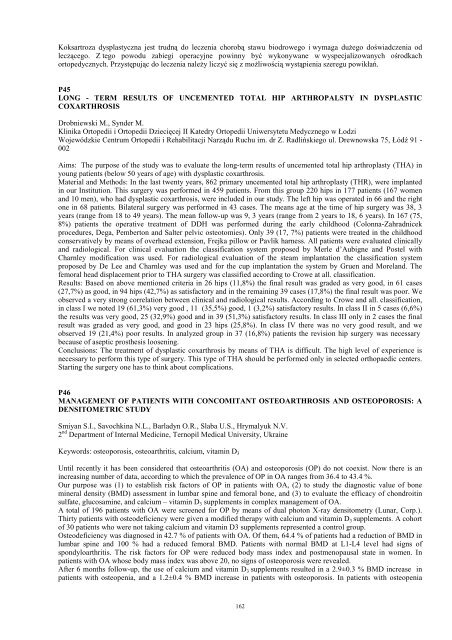I_kongres_streszczenia.pdf
I_kongres_streszczenia.pdf
I_kongres_streszczenia.pdf
You also want an ePaper? Increase the reach of your titles
YUMPU automatically turns print PDFs into web optimized ePapers that Google loves.
Koksartroza dysplastyczna jest trudną do leczenia chorobą stawu biodrowego i wymaga duŜego doświadczenia od<br />
leczącego. Z tego powodu zabiegi operacyjne powinny być wykonywane w wyspecjalizowanych ośrodkach<br />
ortopedycznych. Przystępując do leczenia naleŜy liczyć się z moŜliwością wystąpienia szeregu powikłań.<br />
P45<br />
LONG - TERM RESULTS OF UNCEMENTED TOTAL HIP ARTHROPALSTY IN DYSPLASTIC<br />
COXARTHROSIS<br />
Drobniewski M., Synder M.<br />
Klinika Ortopedii i Ortopedii Dziecięcej II Katedry Ortopedii Uniwersytetu Medycznego w Łodzi<br />
Wojewódzkie Centrum Ortopedii i Rehabilitacji Narządu Ruchu im. dr Z. Radlińskiego ul. Drewnowska 75, Łódź 91 -<br />
002<br />
Aims: The purpose of the study was to evaluate the long-term results of uncemented total hip arthroplasty (THA) in<br />
young patients (below 50 years of age) with dysplastic coxarthrosis.<br />
Material and Methods: In the last twenty years, 862 primary uncemented total hip arthroplasty (THR), were implanted<br />
in our Institution. This surgery was performed in 459 patients. From this group 220 hips in 177 patients (167 women<br />
and 10 men), who had dysplastic coxarthrosis, were included in our study. The left hip was operated in 66 and the right<br />
one in 68 patients. Bilateral surgery was performed in 43 cases. The means age at the time of hip surgery was 38, 3<br />
years (range from 18 to 49 years). The mean follow-up was 9, 3 years (range from 2 years to 18, 6 years). In 167 (75,<br />
8%) patients the operative treatment of DDH was performed during the early childhood (Colonna-Zahradnicek<br />
procedures, Dega, Pemberton and Salter pelvic osteotomies). Only 39 (17, 7%) patients were treated in the childhood<br />
conservatively by means of overhead extension, Frejka pillow or Pavlik harness. All patients were evaluated clinically<br />
and radiological. For clinical evaluation the classification system proposed by Merle d’Aubigne and Postel with<br />
Charnley modification was used. For radiological evaluation of the steam implantation the classification system<br />
proposed by De Lee and Charnley was used and for the cup implantation the system by Gruen and Moreland. The<br />
femoral head displacement prior to THA surgery was classified according to Crowe at all. classification.<br />
Results: Based on above mentioned criteria in 26 hips (11,8%) the final result was graded as very good, in 61 cases<br />
(27,7%) as good, in 94 hips (42,7%) as satisfactory and in the remaining 39 cases (17,8%) the final result was poor. We<br />
observed a very strong correlation between clinical and radiological results. According to Crowe and all. classification,<br />
in class I we noted 19 (61,3%) very good , 11 (35,5%) good, 1 (3,2%) satisfactory results. In class II in 5 cases (6,6%)<br />
the results was very good, 25 (32,9%) good and in 39 (51,3%) satisfactory results. In class III only in 2 cases the final<br />
result was graded as very good, and good in 23 hips (25,8%). In class IV there was no very good result, and we<br />
observed 19 (21,4%) poor results. In analyzed group in 37 (16,8%) patients the revision hip surgery was necessary<br />
because of aseptic prosthesis loosening.<br />
Conclusions: The treatment of dysplastic coxarthrosis by means of THA is difficult. The high level of experience is<br />
necessary to perform this type of surgery. This type of THA should be performed only in selected orthopaedic centers.<br />
Starting the surgery one has to think about complications.<br />
P46<br />
MANAGEMENT OF PATIENTS WITH CONCOMITANT OSTEOARTHROSIS AND OSTEOPOROSIS: A<br />
DENSITOMETRIC STUDY<br />
Smiyan S.I., Savochkina N.L., Barladyn O.R., Slaba U.S., Hrymalyuk N.V.<br />
2 nd Department of Internal Medicine, Ternopil Medical University, Ukraine<br />
Keywords: osteoporosis, osteoarthritis, calcium, vitamin D3<br />
Until recently it has been considered that osteoarthritis (OA) and osteoporosis (OP) do not coexist. Now there is an<br />
increasing number of data, according to which the prevalence of OP in OA ranges from 36.4 to 43.4 %.<br />
Our purpose was (1) to establish risk factors of OP in patients with OA, (2) to study the diagnostic value of bone<br />
mineral density (BMD) assessment in lumbar spine and femoral bone, and (3) to evaluate the efficacy of chondroitin<br />
sulfate, glucosamine, and calcium – vitamin D3 supplements in complex management of OA.<br />
A total of 196 patients with OA were screened for OP by means of dual photon X-ray densitometry (Lunar, Corp.).<br />
Thirty patients with osteodeficiency were given a modified therapy with calcium and vitamin D3 supplements. A cohort<br />
of 30 patients who were not taking calcium and vitamin D3 supplements represented a control group.<br />
Osteodeficiency was diagnosed in 42.7 % of patients with OA. Of them, 64.4 % of patients had a reduction of BMD in<br />
lumbar spine and 100 % had a reduced femoral BMD. Patients with normal BMD at L1-L4 level had signs of<br />
spondyloarthritis. The risk factors for OP were reduced body mass index and postmenopausal state in women. In<br />
patients with OA whose body mass index was above 20, no signs of osteoporosis were revealed.<br />
After 6 months follow-up, the use of calcium and vitamin D3 supplements resulted in a 2.9±0.3 % BMD increase in<br />
patients with osteopenia, and a 1.2±0.4 % BMD increase in patients with osteoporosis. In patients with osteopenia<br />
162


